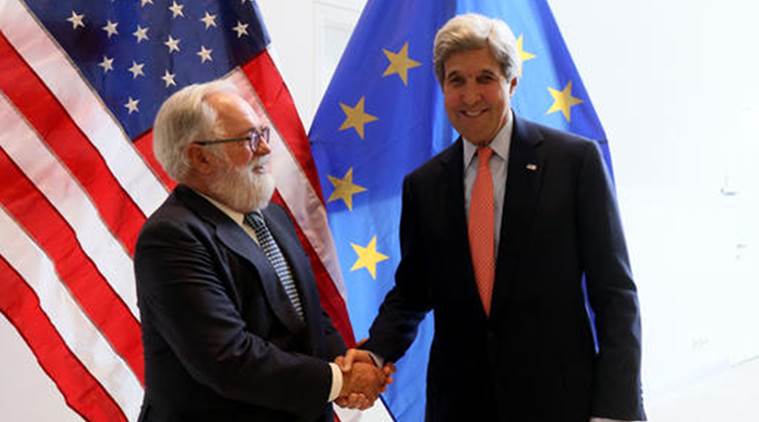Stay updated with the latest - Click here to follow us on Instagram
Climate change: Deal on cutting HFC greenhouse gases in sight for 2016, say Vienna delegates
US Secretary of State John Kerry was among those who took part in high-level talks on Friday. The conference ended early on Sunday.
 European Union Climate Commissioner Miguel Arias Canete welcomes US Secretary of State John Kerry, from left, for talks to reduce hydrofluorocarbons under the Montreal Protocol at Vienna International Center in Vienna. (AP Photo)
European Union Climate Commissioner Miguel Arias Canete welcomes US Secretary of State John Kerry, from left, for talks to reduce hydrofluorocarbons under the Montreal Protocol at Vienna International Center in Vienna. (AP Photo)
A global agreement on cutting the use of hydrofluorocarbons (HFCs) – potent greenhouse gases used in aerosols, refrigerants and air conditioning – seems within grasp, delegates said after ten days of talks on climate change in Vienna on Sunday.
A final deal is expected to reached at a meeting in October in Kigali, Rwanda. If successful, it would be the biggest single measure to limit global warming since governments adopted the Paris Agreement last December, seeking to limit heat waves, floods, droughts and rising seas.
At the Vienna talks, the last before the Kigali meeting, almost 200 countries convened to lay the groundwork for such a deal, hammering out details and timetables for almost eliminating use of HFCs.
Governments “succeeded in laying the ground work for adoption of an ambitious HFC amendment … in Kigali,” the US Environmental Protection Agency (EPA) said in a statement.
US Secretary of State John Kerry was among those who took part in high-level talks on Friday. The conference ended early on Sunday.
Under the current draft of the agreement, rich nations would get a target of almost eliminating HFCs by the 2030s, while poorer nations – which may struggle with the high costs of shifting to new technologies – would get a decade or so longer.
“The odds are very high for a deal in Kigali,” David Doniger of the US Natural Resources Defense Council told Reuters.
Developing nations would also get financial support from nations led by the United States and the European Union. India was least ambitious among major nations, favouring a freeze on growth in HFCs only in 2031.
“This single step could avoid up to 0.5 degrees Celsius (0.9 Fahrenheit) of warming by 2100,” the EPA said of cutting use of HFCs.
Watch Video: What’s making news
Paris set a goal of phasing out greenhouse gas emissions by 2100, mainly by shifting away from fossil fuels, and a target of limiting a rise in average global surface temperatures to “well below” 2C above pre-industrial times.
Temperatures in 2016 are on track to be the warmest on record, eclipsing 2015, according to the World Meteorological Organization. Temperatures are already about 1C above pre-industrial times.
The HFC talks are part of the 1987 Montreal Protocol, which succeeded in slashing the use of chlorofluorocarbons (CFCs) to help protect the ozone layer, which shields the planet from ultraviolet rays that can cause skin cancer.
But the HFCs that have often replaced them, while better for the ozone layer, are greenhouse gases thousands of times more potent than carbon dioxide.
“These negotiations narrowed gaps on key issues like the HFC phase out timetables, creating strong momentum for Kigali,” said Paul Bledsoe, a former Clinton White House climate adviser attending the talks.
Photos



- 01
- 02
- 03
- 04
- 05




























